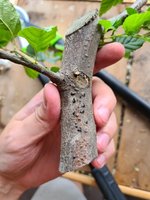itisoktodance
Sapling
Images:


This is on a European hornbeam (carpinus betulus) cultivated for bonsai.
I cut off part of a branch that I wanted to shorten and noticed weird black and brown bumps along a line on the branch. When I looked at the cross-section, there was a darkened segment that looked like the wood was rotting.
Does anyone have any idea what it might be? Could it be harmful? If so, what should I do to remedy this? A person on reddit suggested it might have been damage from beetle larvae?
I am reluctant to cut off that entire branch as it's pivotal to the design of the tree, but I could cut a little lower and carve out the part that looks dead/diseased. Would that be enough to stop the possible pathogen from spreading, or is cutting off the entire branch the only option?
Thank you in advance for your help!


This is on a European hornbeam (carpinus betulus) cultivated for bonsai.
I cut off part of a branch that I wanted to shorten and noticed weird black and brown bumps along a line on the branch. When I looked at the cross-section, there was a darkened segment that looked like the wood was rotting.
Does anyone have any idea what it might be? Could it be harmful? If so, what should I do to remedy this? A person on reddit suggested it might have been damage from beetle larvae?
I am reluctant to cut off that entire branch as it's pivotal to the design of the tree, but I could cut a little lower and carve out the part that looks dead/diseased. Would that be enough to stop the possible pathogen from spreading, or is cutting off the entire branch the only option?
Thank you in advance for your help!

